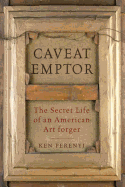
To read Ken Perenyi's account of his 30 years peddling art forgeries, one would think anybody could do it. Perenyi dropped out of his Hoboken, N.J., high school and took up with some young NYC artists in the 1960s. Perenyi found that he could live a footloose, job-free life by faking Old Master paintings, complete with distressed frames and markings, and selling them through Sotheby's, Christie's and the like. Caveat Emptor is a detailed confession of how he did it and how he got away with it for three decades before the FBI closed in--a confession he can make now that the statute of limitations has expired.
Perenyi's book includes illustrations of his fakes and countless how-tos of his trade. Focusing on mid-value, prolific 19th-century British and American artists whose works were frequently repetitive, he usually claimed to have inherited or "just found" the many copies he sold. Because these artists were relatively low priced, his $1,000 and $2,000 forgeries stayed out of the limelight. Perenyi's work was so good he never had to produce a fake provenance, never had to create a paper trail of his decades of subterfuge.
Caveat Emptor provides a fascinating look into the world of antique paintings and the process of their vetting and selling. What it doesn't much explore are Perenyi's motivations. The closest we come to uncovering his reasons is when he describes closing down his Florida shop before the feds can make their case: "Everything I owned was paid for, and I hadn't a nickel of debt," he writes. "I had around a million, all cash, and that didn't include my stock portfolio." --Bruce Jacobs, founding partner, Watermark Books & Cafe, Wichita, Kan.

